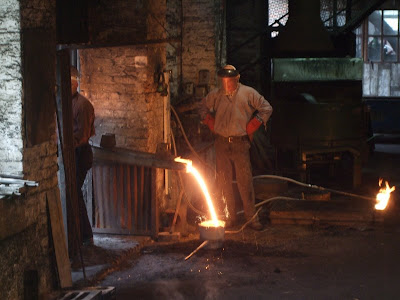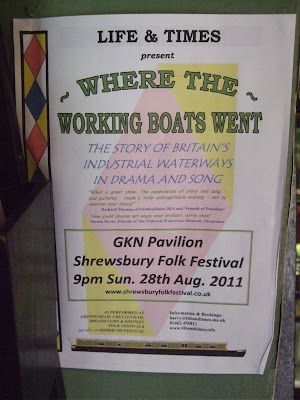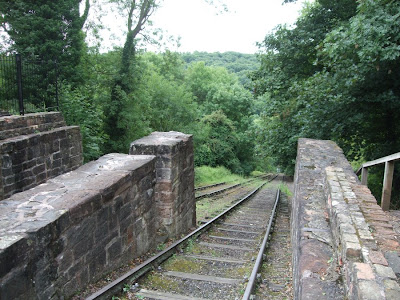One of the museums in Ironbridge Gorge is
Blists Hill Victorian Town. This is a mixture of original industrial remains - blast furnaces, mine shafts and a brick and tile works - and recreated shops and businesses from the nineteenth century. It feels rather like the
Black Country Living Museum, and I loved it. So much so that we went back three days after our first visit.

We made sure we were in the New Inn for the music hall singing. This was excellent: two men in period clothes started a banter in loud voices, then one sat at the piano and started playing. Both men sang lustily and well. There were moments, especially when the characters held my eye, when I had a very strong feeling of being in the film
Westworld. Spooky!
But to the real excitement. On Sunday we saw moulds being created from "green sand". This was actually black, after starting off yellow. It goes black after coming into contact with the molten iron and associated gases. The sand has about four per cent clay added, and is slightly dampened. This helps it to mould to the shape of the pattern, and to keep the shape when the pattern is removed. After being energetically tamped down the outer casing, which goes round just the sides, is removed, leaving the sand in a cuboid form - sitting on a small wooden pallet - with nothing but air where the iron is to go.

On Wednesday the cupula furnace was charged with coke, limestone and scrap iron. Once it's given a little heat the coke burns fiercely in the air which is blown in, and the furnace doesn't need any external heat. We missed that, but saw the next stages of the process.

The resultant molten iron was allowed to flow down a chute into a bucket.

This was then manhandled over the moulds and the iron poured in to the filling hole.

At one point in the process molten slag was tapped off, being allowed to flow onto the ground outside. This was accompanied by a spectacular shower of sparks.

After 30 minutes to an hour the pallets were picked up and thrown onto the floor, causing the sand to break up around the precious solid inside.

And here is one finished article. Something for Ruth and Mark's sixth wedding anniversary!

Despite all the skill invlolved, sometimes mistakes can creep in.

Oops!

I wonder which will last longer: the cast iron sign or my photo of it on the internet?






































































